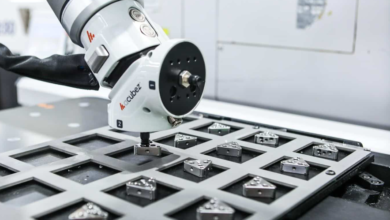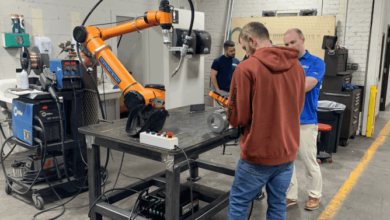Ways SINTRONES’ NVIDIA Jetson AGX Orin is Revolutionizing Smart Traffic Signals

In busy cities, effective traffic management is crucial for balancing cars and pedestrians. SINTRONES has created a new technology, powered by NVIDIA’s Jetson AGX Orin, to improve how we travel in cities. Imagine traffic lights that don’t just change from red to green but adjust in real-time based on how many cars and people are around.
This helps reduce traffic jams and makes streets safer. As cities grow and become more crowded, this technology offers smart traffic signals and a safer way for everyone—drivers, commuters, and city planners—to navigate the streets.
I. Real-Time Traffic Flow Adaptation
AI and machine learning models process data from cameras, sensors, and connected vehicles to adjust traffic signal timings based on current traffic conditions, reducing delays and optimizing traffic flow.
Role of Sensors, Cameras, and Data Analysis: Integrated sensors and cameras provide real-time traffic data, which is processed locally by Sintrones’ edge AI systems for quick responses to changing traffic patterns.
Benefits of Adaptive Signal Control:
Reduced Congestion: Traffic flow is optimized, decreasing congestion.
Improved Travel Times: Signal adjustments minimize delays.
Enhanced Safety: Real-time adjustments help prevent accidents.
Environmental Benefits: Smoother traffic flow reduces emissions and fuel consumption.
Sintrones’ AI-powered traffic management systems enhance urban mobility by improving traffic flow, safety, and sustainability through adaptive signal control and real-time data analysis.
See also: Can Wearable Technology Lower Health Insurance Premiums?
II. Improved Pedestrian and Vehicle Safety
Sintrones enhances pedestrian and vehicle safety through AI-powered traffic management systems that prioritize vulnerable road users and emergency vehicles while adjusting traffic signals based on real-time conditions.
AI-Driven Prioritization: Sintrones uses AI to detect pedestrians, cyclists, and emergency vehicles, adjusting traffic signals to give them priority for safer crossings and quicker passage.
Real-Time Signal Adjustments: Edge AI computing allows for instant signal changes based on current traffic conditions, reducing congestion and improving traffic flow.
Accident Reduction: By dynamically adjusting signals and prioritizing vulnerable users, Sintrones helps reduce traffic accidents, using AI-powered surveillance for timely hazard detection.
Sintrones’ AI solutions create safer urban environments by improving traffic safety for pedestrians and vehicles.
III. Predictive Traffic Management
Predictive traffic management systems are transforming urban mobility by forecasting traffic patterns and optimizing traffic flow using both historical and real-time data, particularly during peak hours.
Forecasting Traffic Patterns: These systems predict traffic conditions and adjust signals to prevent congestion by analyzing past data, sensor inputs, and road usage.
Integrating Data: They combine historical data with live inputs from sensors and cameras to adjust signal timings based on current traffic, improving efficiency and reducing congestion.
Reducing Congestion During Peak Hours: The systems help alleviate congestion, as seen in Ann Arbor, Michigan, where an intelligent traffic control system reduced travel times by 12% on weekdays and 21% on weekends.
Predictive traffic management enhances urban mobility by improving traffic flow, reducing congestion, and increasing efficiency.
IV. Scalable and Flexible System for Urban Growth
Sintrones’ smart traffic management systems are designed to support city growth and adapt to new technologies, ensuring long-term benefits for urban mobility.
Scalability for Growing Cities: Using edge AI computing, Sintrones’ systems enable real-time traffic management and can easily integrate additional sensors and devices as cities expand.
Compatibility with Smart City Technologies: Their systems work seamlessly with technologies like autonomous vehicles and IoT sensors, ensuring future-proof compatibility with emerging tech.
Long-Term Benefits of AI-Powered Management: AI systems optimize traffic flow, reduce congestion, and improve safety, while continuously adapting to changing urban conditions through predictive analytics.
Sintrones provides scalable, adaptable traffic management solutions that grow with cities and support the integration of future technologies for more efficient transportation networks.
V. Environmental Benefits
Sintrones’ smart traffic management systems contribute to environmental sustainability by reducing carbon emissions, improving energy efficiency, and supporting green urban planning through AI-driven technologies.
Reduced Carbon Emissions and Optimized Traffic Flow: Sintrones’ systems use edge AI to adjust traffic signals in real time, reducing idle times and congestion. This optimization leads to smoother traffic flow, which decreases fuel consumption and lowers CO₂ emissions.
Energy-Efficient Signal Systems: Sintrones’ smart systems use low-energy, high-performance technology to reduce power use and support eco-friendly traffic management.
AI-Driven Support for Green Urban Planning: Sintrones uses AI and live data from sensors to improve traffic flow and reduce traffic jams. This helps cities become more eco-friendly and supports plans for cleaner, greener transportation.
Sintrones’ AI-powered traffic management systems help reduce environmental impacts by optimizing traffic flow, boosting energy efficiency, and supporting sustainable city planning.
VI. The Impact on City Planning and Infrastructure
Sintrones’ smart traffic systems help city planners make better decisions using real-time data. They work well with other smart city systems, save money by improving traffic flow, and reducing the need for expensive upgrades.
Data-Driven Decision Support for City Planners: Sintrones’ systems use edge AI to process real-time traffic data locally, allowing city planners to make timely, informed decisions about traffic flow, infrastructure, and resource allocation. With over 1,000 cameras providing detailed traffic monitoring, these systems operate smoothly without network congestion, even during peak traffic.
Integration into Broader Smart City Infrastructure: Their smart traffic signals work with other smart city technologies, such as autonomous vehicles, IoT sensors, and 5G networks. This integration creates intelligent transportation systems that improve traffic management and reduce congestion.
Long-Term Cost Savings and Efficiency: Sintrones’ systems help reduce fuel consumption and maintenance costs by optimizing traffic flow and decreasing congestion. Their edge AI solutions are scalable, making it easy to expand as cities grow without significant additional investment.
Sintrones’ smart traffic management systems help city planners make data-driven decisions, integrate with other smart city technologies, and deliver long-term savings and improved efficiency.
Conclusion
Sintrones’ smart traffic signals, powered by NVIDIA’s Jetson AGX Orin, are revolutionizing how cities manage traffic. These signals use artificial intelligence (AI) and real-time data to adjust the timing of traffic lights based on current conditions, which helps improve traffic flow, make streets safer, and reduce pollution. The system prioritizes pedestrians and emergency vehicles, ensuring their safety by adjusting the signals for smoother crossings and quicker passage.
Additionally, these signals can predict traffic patterns and adjust accordingly to reduce delays and avoid congestion. The technology is flexible, meaning it can easily integrate with other smart city systems, such as those for autonomous vehicles or IoT devices. This adaptability allows for a more connected and efficient city infrastructure.
Moreover, Sintrones’ system provides valuable data that helps city planners make informed decisions about traffic management and infrastructure development. This leads to transportation systems that are not only safer and more efficient but also better for the environment and capable of growing with the needs of expanding cities.




